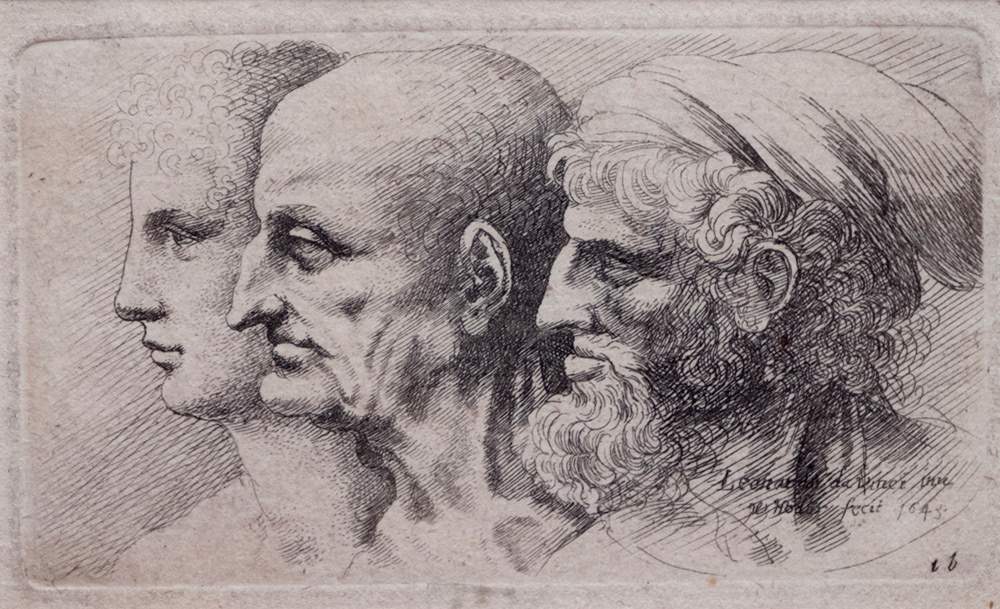From Dec. 16, 2018 to May 5, 2019, the Rossana & Carlo Pedretti Foundation in Vinci (Florence) inaugurates its exhibition activities at its new location in Villa Baronti-Pezzatini (a recently restored historic building) with the exhibition Leonardo designed by Hollar. The exhibition, curated by Annalisa Perissa Torrini, is the first of the events realized by the Pedretti Foundation and is dedicated precisely to Carlo Pedretti, the recently deceased scholar who was among the world’s greatest connoisseurs of the art of Leonardo da Vinci (Vinci, 1452 - Amboise 1519). It was Pedretti himself, in fact, who wanted to enhance the thirty-one engravings by Wenceslaus Hollar (Prague, 1607 - London, 1667) with a Leonardo theme, which he acquired in the 1950s. These are rare evidence ofinterest in Leonardo’s drawings in the seventeenth century and an important vehicle for the study and dissemination of Leonardo’s drawings of caricatures and grotesques. Those on display, never before exhibited, are not just any engravings but often of the “first states,” or works drawn directly by the artist. And this is the first exhibition devoted to Hollar’s engravings to be held in Italy.
Leonardo’s primary interest in depicting emotions in portraits focuses on all manifestations of moods, amplified by the freshness of youth or the decay of senility. In drawings, Leonardo is immediate and spontaneous: on paper, his taste for the grotesque and his desire to highlight physiognomic anomalies find full freedom of expression. With pen and ink come the charged and grotesque heads, constantly changing and increasingly exaggerated deformations of human character, which “without effort are kept in mind.” Reflecting Leonardo’s fascination with the infinitely ugly, deformed, decadent, unpleasant as the exact opposite of the infinitely beautiful, depicted in his faces of divine sweetness and supreme beauty. As he himself noted, “Beauty with ugliness seems more powerful for each other.”
In the exhibition, Hollar’s etchings will be compared with two drawings by Leonardo, an exceptional loan from the Biblioteca Ambrosiana in Milan. Documenting the close relationship between the engravings and Leonardo’s originals, they will be displayed alongside each other. Another explicit juxtaposition is established between two drawings by Francesco Melzi from the Belt Library in Los Angeles and Hollar’s engravings. Francesco (Milan, 1491/93 - Vaprio d’Adda, 1568), son of Gerolamo Melzi, captain of the Milanese militia, received a humanistic education and as soon as he was 15 became a pupil of Leonardo da Vinci. He was united with him by a relationship of deep friendship and was named his heir by him.
The visual documentation between the drawings and prints is a rather rare comparison that is important for knowledge of graphic art. “Hollar,” says Annalisa Perissa, “was, without a doubt, one of the greatest and most generous engravers of all time, and this despite near-blindness in one eye, and his prints from Leonardo’s drawings, fundamental to their dissemination, are presented here for the first time in Italy as the focus of an exhibition of graphic art.” The Bohemian engraver extrapolates profiles of men, charged heads, bizarre heads and grotesque heads from several of Leonardo’s drawings individually or in numbers of three, four and even more, combining them into a single engraving. Often maintaining, as the studies conducted on this occasion propose, the 1:1 ratio. He had had Leonardo’s originals in his hands, many now in the English royal collections at Windsor Castle, when he was in London with Lord Arundel, a diplomat and noted collector. Hollar often associates the young with the old and the ugly with the beautiful, reflecting Leonardo’s thoughts on beauty and ugliness, so explicated by him in paragraph 13 of The Book of Painting: “If the painter wishes to see beauties that will enamor him, he is lord of generating them, and if he wishes to see things so monstrous that they frighten, or that are buffoonish and laughable, or truly compassionate, he is lord and God of them.”
Alongside the “grotesque heads,” the exhibition features another, small group of Hollar’s engravings taken from Leonardo’s anatomical drawings. Fascinating Hollar seems to be some particular themes, such as the skulls found in the English royal collections of Leonardo’s drawings. A number of volumes, granted to the exhibition by the Biblioteca Leonardiana in Vinci, document the sources of Leonardo’s knowledge, as well as the continuity of printed reproductions of the drawings, also presenting the work of Caylus Anne Claude Philippe de Tubières, a fine 18th-century engraver. In all, including engravings, drawings and volumes, the public will find some 50 works on display. Trilingual catalog (Italian, English and Russian) with texts by Michael W. Kwakkelstein, Sara Taglialagamba, Margherita Melani, Roberta Barsanti, Carla Gütermann. The exhibition has the patronage of the National Committee for the Five Hundredth Anniversary of the Death of Leonardo da Vinci and is therefore part of the national celebrations dedicated to the master from Vinci in Italy in 2019.
Image: Wenceslaus Hollar Three Manly Profiles of Various Ages (1645; etching, 52 x 92 mm the engraving, 53 x 94 mm the print), 60 x 98 mm the mounting window; Lamporecchio, Rossana & Carlo Pedretti Foundation)
 |
| Leonardo da Vinci drawn by Hollar: with unpublished engravings kicks off Pedretti Foundation's exhibition activities |
Warning: the translation into English of the original Italian article was created using automatic tools. We undertake to review all articles, but we do not guarantee the total absence of inaccuracies in the translation due to the program. You can find the original by clicking on the ITA button. If you find any mistake,please contact us.